Dr. Frances Arnold got the noble for directing evolution (read ‘micro-evolution’) to generate new enzymes. This is a precious example of design in chemistry and what intelligent design can do.
No natural and random process had produced the new enzymes. It was produced by meticulously planning and directing the process of micro-evolution. She and her colleagues were directing the ‘copying error’ to improve sub-function of an existing enzyme which usually engage in different chemical reaction.
But, why they had to take a tedious route to invent new enzymes? That is because, we do not yet know how a particular chain and sequence of amino acids would function assuming a particular shape. If we could have gathered all that information at that tiny level we could have produced new enzyme de-novo.
In fact Dr. Arnold explains precisely that in one of her articles:
“Unfortunately, our understanding of the link between sequence and function lags well behind our desire for new enzymes. Given that our ability to predict protein sequences–or even just changes to a sequence–that reliably give rise to whole new, finely tuned catalytic activities is rudimentary at best, creating new enzymes capable of improving on current synthetic processes is a pretty tall order. We also dream of going beyond known chemistry to create enzymes that catalyze reactions or make products that are simply not possible with any known method, synthetic or otherwise. Requiring that these new enzymes assemble and function in cells, where they can be made at low cost and incorporated into synthetic metabolic pathways to generate a broader array of products, represents an even greater set of engineering constraints and challenges.(1)”
She also writes:
“Directed evolution achieves these desirable functional outcomes while circumventing our deep ignorance of how sequence encodes them”
The new function the enzyme achieved was not completely new. Usually they chose the enzymes from the natural world which were doing other important function but also had the desired catalytic capacity in a minimal level. By directing the copying error process Dr. Arnold’s team tried to improvise that desired function. On her own words:
“We start with existing proteins (sourced from Nature or engineered), introduce mutations, and then screen for the progeny proteins with enhanced activity (or another desirable trait). We use the improved enzymes as parents for the next round of mutation and screening, recombining beneficial mutations as needed and continuing until we reach the target level of performance.(1)”
I am not speaking of ‘copying error’ out of ignorance. Read her own comments on the issue:
“Engineering enzymes in the 1980s and 1990s, I learned the hard way that there was no reliable method to predict performance-enhancing mutations. Turning instead to random mutagenesis and screening, I quickly realized that such mutations were easy to find and accumulate with the right evolutionary optimization strategy(1).” I wanted to go deep. But let’s stop it here. Given the circumstances we can conclude that this year the noble prize was given to intelligent design(2,3).
1. Arnold FH. Directed Evolution: Bringing New Chemistry to Life. Angew Chemie – Int Ed. 2018;57(16):4143–8.
2. Douglas Axe. Nobel Prize in Chemistry for Intelligent Design? | Evolution News [Internet]. [cited 2018 Oct 19]. Available from: https://evolutionnews.org/2018/10/nobel-prize-in-chemistry-for-intelligent-design/
3. Michael Egnor. Intelligent Design Wins Another Nobel Prize | Evolution News [Internet]. 2018 [cited 2018 Oct 19]. Available from: https://evolutionnews.org/2018/10/intelligent-design-wins-another-nobel-prize/
